Your Guide to Jökulsárlón Glacier Lagoon
June 17, 2022
Your Guide to Jökulsárlón Glacier Lagoon
June 17, 2022
Set in the famed Vatnajökull National Park, the Jökulsárlón glacier lagoon is one of the most glorious sights on Iceland’s south coast. On a visit to this enchanting landscape, you’ll witness serene floating icebergs, black-sand beaches, Iceland’s unique wildlife, and so much more.
In this blog post, you’ll discover what makes Jökulsárlón just so special. And we’ll give you some practical tips and travel advice for visiting the site too.
By the way, some of our South Coast tours visit the Jokulsarlon glacier lagoon.
Read on to find out why they’re the most convenient way to reach one of the most incredible parts of Iceland.
What is the Jökulsárlón glacier lagoon?
For those who don’t know, Jökulsárlón glacier lagoon is the deepest lake in Iceland. But it’s not just any normal lake. What makes it so special is the way it’s formed by the melting glaciers of the Vatnajökull National Park.
Currently, the lagoon is about 11 square miles in size (18 square kilometres). But it hasn’t always been this expansive. In fact, before the 1930s, Jökulsárlón wasn’t there at all—and, over the last 50 years, the lake has quadrupled in size. It will continue to grow as temperatures rise.
As such, this gorgeous landform—with its drifting icebergs and hunting seals—is a testament to a warming world. If you’re lucky, you may experience for yourself the dramatic crumple and crash of blocks of ice that fall from the shrinking glacier. That ice you’re witnessing fall is thousands of years old.
The changing conditions in the area add an extra poignancy to the scene. Indeed, it’s a place that may not be here forever.
Why is Jökulsárlón so famous?
The Jökulsárlón glacial lagoon is without a doubt one of the most popular sights in southern Iceland. And to see it for yourself, you’ll immediately understand why. Quite simply, Jökulsárlón offers everything visitors dream of when they come to Iceland, including majestic glacial landscapes and otherworldly coastal scenes.
Yet part of the area’s fame comes from its frequent use as a filming location. The James Bond films, Die Another Day and A View to a Kill, both include scenes shot at the lagoon. Scenes in Lara Croft: Tomb Raider were also set here.
Parts of other films, meanwhile, including Batman Begins, Interstellar, and The Secret Life of Walter Mitty, were all filmed in the surrounding area. And we shouldn’t forget the music videos for Justin Bieber’s “I’ll Show You” and Bon Iver’s “Holocene”.
Visit the lagoon for yourself and you’ll see exactly why it’s such an inspiring place.
Where is Jökulsárlón glacier lagoon located?
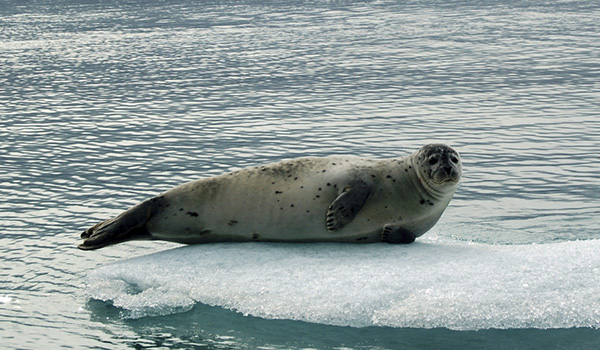
The Jökulsárlón glacier lagoon is located on Iceland’s south coast, between the towns of Vík í Mýrdal and Höfn. You’ll find it right next to Route 1, the circular road that traverses the entirety of Iceland’s coast.
Jökulsárlón itself sits at the southern end of the Vatnajökull National Park, the second largest national park in all of Europe. And it’s the Vatnajökull glacier—Europe’s biggest ice cap—that feeds the lake with its melting ice.
More specifically, the glacier that sustains the lagoon is the Breiðamerkurjökull, a tongue from the larger parent glacier. This has retreated by 3.5 miles (5.6km) over the last century, leaving the lagoon in its place.
Thanks to its location right next to Route 1, Jökulsárlón is really easy to access, no matter which way you’re approaching. If you’re arriving from Reykjavik, the journey is about 236 miles (380km). It typically takes between 5 and 6 hours.
Top things to do at Jökulsárlón glacier lagoon
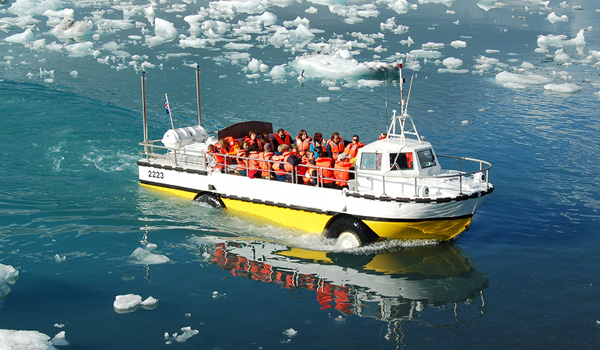
So what can you get up to at Jökulsárlón? Here are the four best things you can do on the glacial lagoon.
Just enjoy your surroundings.
One of the most beautiful things to do at Jökulsárlón is also the easiest: simply admire the view. With its floating icebergs and amazing sea life, the lagoon offers up truly incredible scenes. Soak it all in, because you won’t be in a place like this every day.
Take a boat tour.
You can get closer to the magic and wonder of Jökulsárlón on a boat tour of the glacial lagoon. The trip will take you among the icebergs to show you the beauty of the whole lake. For those who want front-row seats to one of the country’s most incredible sights, this opportunity’s not to be missed.
Join an ice cave tour.
Jökulsárlón happens to be one of the best places in southern Iceland to go caving beneath the ice. Every autumn, these ice caves begin to take shape across the southern side of Vatnajökull. Venturing into these spaces on an ice cave tour makes for a once-in-a-lifetime experience.
See the northern lights.
Iceland is an incredible place to see the aurora borealis—and there’s no more magical location to see them than Jökulsárlón.
However, that’s not all there is to enjoy around the Jökulsárlón glacial lagoon:
Attractions near Jökulsárlón glacier lagoon
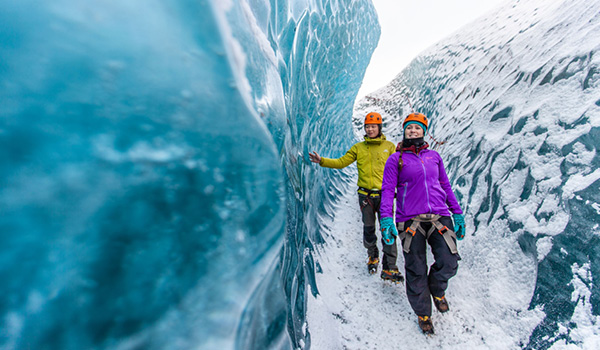
Jökulsárlón sits at the heart of one of the most incredible coastlines in Iceland (if not the world). It also nestles within the Vatnajökull National Park. This means that there’s a serious amount to see and do in the area.
Let’s take a look at the highlights you should make sure you see.
Diamond Beach
Breiðamerkursandur—better known as the Diamond Beach—makes up part of the area of the glacial lagoon. More accurately, it’s this dark strip of sand that separates the lagoon from the vast expanse of the Atlantic Ocean. If you’re visiting Jökulsárlón, it’s likely you’ll see the Diamond Beach too.
But this is not any old beach. Firstly, like many beaches in south Iceland, Breiðamerkursandur is known for its black sand. This is the product of the volcanic landscape where you find it—thanks to the area’s basalt lava.
But most importantly, Breiðamerkursandur took the name Diamond Beach for a reason. That’s the glistening, blueish chunks of ice that wash up onto this strip of sand. They really do look like pieces of glass, or shards of diamond. In how many other places in the world can you see both a glacier and beach together?
Vatnajökull National Park
The Vatnajökull National Park is one of the largest national parks in Europe and home to Europe’s largest glacier. As you may well imagine, this makes it an incredible place to visit.
During the summer, for example, it’s an awe-inspiring area to explore on foot, with thousands of kilometres of hiking trails criss-crossing the wilderness. And the Snæfell Wilderness, for example—where you’ll see the Snæfell, Iceland’s largest mountain not covered by glaciers—is home to Iceland’s few herds of reindeer.
A popular alternative is to explore the park by snowmobile. To glide across the top of the Vatnajökull ice cap is an unforgettable thrill.
Skaftafell
What was once the national park of Skaftafell is now a part of the larger Vatnajökull park. But that doesn’t take away its unique character, nor its diverse beauty.
Skaftafell is another area in southern Iceland known for its hiking trails. But unlike many of the trails you’d find elsewhere in the country, many of these are manageable in a day. That makes this part of the Vatnajökull National Park a great place for shorter adventures, including the Blue Ice Experience glacier hike tour.
One of the most popular short trails in Skaftafell takes you to the Svartifoss waterfall—a slender torrent surrounded by hexagonal basalt columns. The strange geometric effect has inspired many visitors, including the designers of the Hallgrímskirkja church in Reykjavik.
Höfn
Höfn is the furthest settlement from Reykjavik on Iceland’s south coast. This lively fishing town is also one of the most charming places to stay in the area.
Its splendid location gives the town its name, meaning ‘harbour’. At the tip of the Hornafjörður fjord, Höfn sits on a peninsula that extends serenely into the Atlantic. It’s a gorgeous spot—and a fantastic base to explore Iceland’s eastern regions.
Kirkjubæjarklaustur
Kirkjubæjarklaustur is often seen as just a pitstop on the way to the natural wonders of Jökulsárlón and Vatnajökull. Yet, thanks to its unique history, this village deserves a visit in its own right.
For instance, over many centuries until the 1500s, Kirkjubæjarklaustur was home to a Benedictine convent—possibly the most northerly Benedictines in the world.
Yet it’s likely the eruption of the nearby Laki volcano that likely has had the biggest impact on the village’s history. When it erupted in 1783, the volcano is thought to have killed half of Iceland’s livestock and caused crop failure across Europe.
Kirkjubæjarklaustur boasts some natural wonders too. For example, the tranquil lake of Systravatn feeds the graceful Systrafoss waterfall a short distance from the village.
How to get to Jökulsárlón glacier lagoon
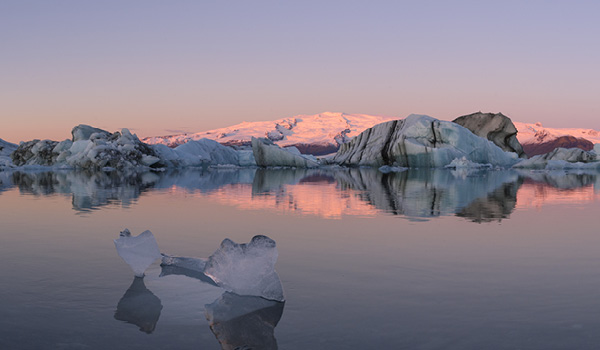
There are so many things to see around Jökulsárlón. But how can you reach the area? Typically, visitors either drive themselves or take a tour.
If you’re driving from Reykjavik, the drive takes between 5 and 6 hours. From Höfn, you’ll arrive at Jökulsárlón in little over an hour. Whichever way you come, it’s important to check the weather conditions before driving, as Route 1 can be exposed to the elements. And this can be tricky for inexperienced drivers.
Alternatively, tours from Reykjavik can take the hassle out of your visit:
• Our Jökulsárlón Glacial Lagoon and Diamond Beach tour combines a visit to the lagoon with some of the must-see highlights along Iceland’s south coast. You’ll see the magical waterfalls of Skógafoss and Seljalandsfoss on the way to Jökulsárlón and stop in Vík í Mýrdal for dinner on the return journey.
• Alternatively, a 2-day South Coast tour gives you the opportunity to visit Jökulsárlón and surrounding sights at a slower pace. On the first day, enjoy the two incredible waterfalls of Skógafoss and Seljalandsfoss before visiting the surrounding glaciers. Then, on the second day, we’ll combine Jökulsárlón with a visit to an ice cave.
• For those who have more time to spare, see all of the major sights on the south coast with our 3-day Jökulsárlón, South Coast, and Golden Circle tour. You’ll start your trip with the three big sights on the Golden Circle—Þingvellir National Park, Geysir Hot Springs, and Gullfoss Waterfall—before journeying east to Vatnajökull and Jökulsárlón.
• Finally, we can also organise private tours to Jökulsarlón for you. You’ll visit Seljalandsfoss, Skógafoss, Skaftafell, as well as the glacier lagoon itself. But this time, you’ll enjoy the ride at your own pace.
Whichever way you decide to travel to Jökulsárlón, it’ll be worth every moment.
How much time do you need at Jökulsárlón glacier lagoon?
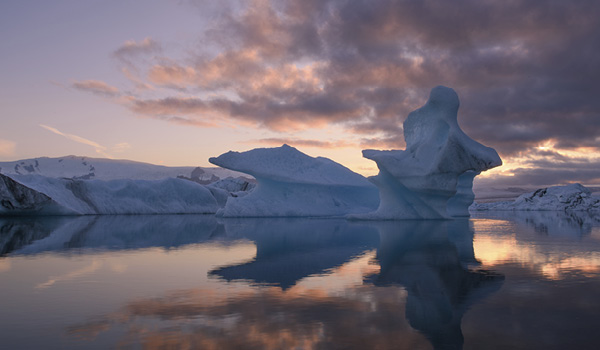
The glacier lagoon rewards any length of stay—and no two journeys to Jökulsárlón are the same. One visitor may want more time at the lagoon than the next.
But, while a visit can fill a whole day, you probably need a minimum of a couple of hours to see everything the area offers.
What is the best time of year to visit Jökulsárlón glacier lagoon?

The Jökulsárlón glacier lagoon is open all year round. That means the best time of year to visit is entirely up to you.
If you would like to see the northern lights at Jökulsárlón, for example, you’ll need to come in the winter. The same goes for ice cave tours, which need the cooler temperatures of autumn and winter. However, boat tours are only available between April and November.
Safety at Jökulsárlón glacier lagoon
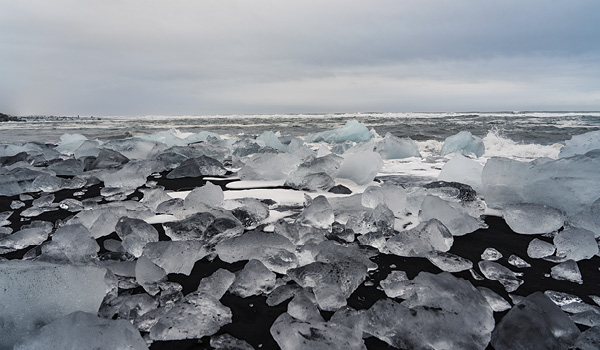
Jökulsárlón glacier lagoon is a very safe destination. But to have the best experience you can, there are some things you should be aware of.
Firstly, we don’t recommend swimming in the lake. The giant icebergs should give you a clue to the temperature of the water—and it may not be safe. Similarly, we suggest that you don’t try to climb on the icebergs (however tempting it might be!).
You should be aware of your safety at Diamond Beach too. Strong currents, unpredictable tides, and volatile weather conditions mean that you may be caught unaware if you’re not careful.
Visit the Jökulsárlón Glacier Lagoon with Reykjavik Excursion
It’s one of the most marvellous sights in all of Iceland. And at Reykjavik Excursions, we can help you visit the Jökulsárlón glacier lagoon in comfort, convenience, and style.
Book a direct tour or combine your trip to Jökulsárlón with other nearby destinations, such as Skaftafell or Vatnajökull. We run tours of Iceland’s south coast throughout the year.
Alternatively, we can help you to arrange multi-day trips or private tours across the coast too.
Wherever you want to explore, trust Reykjavik Excursions to handle the journey. Explore our tours and activities to start your adventure.
Tours in the spotlight
REYKJAVIK EXCURSIONS BLOG
Get inspired! Information and tips and must see places in Iceland, fun facts, customs and more.
The Silver Circle of West Iceland - Your Guide
You’ve heard of the Golden Circle, but here’s why you should head to Iceland’s western region to explore the msytical Silver Circle tour route.
Read BlogYour Guide to Jökulsárlón Glacier Lagoon
June 17, 2022
Your Guide to Jökulsárlón Glacier Lagoon
June 17, 2022
Set in the famed Vatnajökull National Park, the Jökulsárlón glacier lagoon is one of the most glorious sights on Iceland’s south coast. On a visit to this enchanting landscape, you’ll witness serene floating icebergs, black-sand beaches, Iceland’s unique wildlife, and so much more.
In this blog post, you’ll discover what makes Jökulsárlón just so special. And we’ll give you some practical tips and travel advice for visiting the site too.
By the way, some of our South Coast tours visit the Jokulsarlon glacier lagoon.
Read on to find out why they’re the most convenient way to reach one of the most incredible parts of Iceland.
What is the Jökulsárlón glacier lagoon?
For those who don’t know, Jökulsárlón glacier lagoon is the deepest lake in Iceland. But it’s not just any normal lake. What makes it so special is the way it’s formed by the melting glaciers of the Vatnajökull National Park.
Currently, the lagoon is about 11 square miles in size (18 square kilometres). But it hasn’t always been this expansive. In fact, before the 1930s, Jökulsárlón wasn’t there at all—and, over the last 50 years, the lake has quadrupled in size. It will continue to grow as temperatures rise.
As such, this gorgeous landform—with its drifting icebergs and hunting seals—is a testament to a warming world. If you’re lucky, you may experience for yourself the dramatic crumple and crash of blocks of ice that fall from the shrinking glacier. That ice you’re witnessing fall is thousands of years old.
The changing conditions in the area add an extra poignancy to the scene. Indeed, it’s a place that may not be here forever.
Why is Jökulsárlón so famous?
The Jökulsárlón glacial lagoon is without a doubt one of the most popular sights in southern Iceland. And to see it for yourself, you’ll immediately understand why. Quite simply, Jökulsárlón offers everything visitors dream of when they come to Iceland, including majestic glacial landscapes and otherworldly coastal scenes.
Yet part of the area’s fame comes from its frequent use as a filming location. The James Bond films, Die Another Day and A View to a Kill, both include scenes shot at the lagoon. Scenes in Lara Croft: Tomb Raider were also set here.
Parts of other films, meanwhile, including Batman Begins, Interstellar, and The Secret Life of Walter Mitty, were all filmed in the surrounding area. And we shouldn’t forget the music videos for Justin Bieber’s “I’ll Show You” and Bon Iver’s “Holocene”.
Visit the lagoon for yourself and you’ll see exactly why it’s such an inspiring place.
Where is Jökulsárlón glacier lagoon located?

The Jökulsárlón glacier lagoon is located on Iceland’s south coast, between the towns of Vík í Mýrdal and Höfn. You’ll find it right next to Route 1, the circular road that traverses the entirety of Iceland’s coast.
Jökulsárlón itself sits at the southern end of the Vatnajökull National Park, the second largest national park in all of Europe. And it’s the Vatnajökull glacier—Europe’s biggest ice cap—that feeds the lake with its melting ice.
More specifically, the glacier that sustains the lagoon is the Breiðamerkurjökull, a tongue from the larger parent glacier. This has retreated by 3.5 miles (5.6km) over the last century, leaving the lagoon in its place.
Thanks to its location right next to Route 1, Jökulsárlón is really easy to access, no matter which way you’re approaching. If you’re arriving from Reykjavik, the journey is about 236 miles (380km). It typically takes between 5 and 6 hours.
Top things to do at Jökulsárlón glacier lagoon

So what can you get up to at Jökulsárlón? Here are the four best things you can do on the glacial lagoon.
Just enjoy your surroundings.
One of the most beautiful things to do at Jökulsárlón is also the easiest: simply admire the view. With its floating icebergs and amazing sea life, the lagoon offers up truly incredible scenes. Soak it all in, because you won’t be in a place like this every day.
Take a boat tour.
You can get closer to the magic and wonder of Jökulsárlón on a boat tour of the glacial lagoon. The trip will take you among the icebergs to show you the beauty of the whole lake. For those who want front-row seats to one of the country’s most incredible sights, this opportunity’s not to be missed.
Join an ice cave tour.
Jökulsárlón happens to be one of the best places in southern Iceland to go caving beneath the ice. Every autumn, these ice caves begin to take shape across the southern side of Vatnajökull. Venturing into these spaces on an ice cave tour makes for a once-in-a-lifetime experience.
See the northern lights.
Iceland is an incredible place to see the aurora borealis—and there’s no more magical location to see them than Jökulsárlón.
However, that’s not all there is to enjoy around the Jökulsárlón glacial lagoon:
Attractions near Jökulsárlón glacier lagoon

Jökulsárlón sits at the heart of one of the most incredible coastlines in Iceland (if not the world). It also nestles within the Vatnajökull National Park. This means that there’s a serious amount to see and do in the area.
Let’s take a look at the highlights you should make sure you see.
Diamond Beach
Breiðamerkursandur—better known as the Diamond Beach—makes up part of the area of the glacial lagoon. More accurately, it’s this dark strip of sand that separates the lagoon from the vast expanse of the Atlantic Ocean. If you’re visiting Jökulsárlón, it’s likely you’ll see the Diamond Beach too.
But this is not any old beach. Firstly, like many beaches in south Iceland, Breiðamerkursandur is known for its black sand. This is the product of the volcanic landscape where you find it—thanks to the area’s basalt lava.
But most importantly, Breiðamerkursandur took the name Diamond Beach for a reason. That’s the glistening, blueish chunks of ice that wash up onto this strip of sand. They really do look like pieces of glass, or shards of diamond. In how many other places in the world can you see both a glacier and beach together?
Vatnajökull National Park
The Vatnajökull National Park is one of the largest national parks in Europe and home to Europe’s largest glacier. As you may well imagine, this makes it an incredible place to visit.
During the summer, for example, it’s an awe-inspiring area to explore on foot, with thousands of kilometres of hiking trails criss-crossing the wilderness. And the Snæfell Wilderness, for example—where you’ll see the Snæfell, Iceland’s largest mountain not covered by glaciers—is home to Iceland’s few herds of reindeer.
A popular alternative is to explore the park by snowmobile. To glide across the top of the Vatnajökull ice cap is an unforgettable thrill.
Skaftafell
What was once the national park of Skaftafell is now a part of the larger Vatnajökull park. But that doesn’t take away its unique character, nor its diverse beauty.
Skaftafell is another area in southern Iceland known for its hiking trails. But unlike many of the trails you’d find elsewhere in the country, many of these are manageable in a day. That makes this part of the Vatnajökull National Park a great place for shorter adventures, including the Blue Ice Experience glacier hike tour.
One of the most popular short trails in Skaftafell takes you to the Svartifoss waterfall—a slender torrent surrounded by hexagonal basalt columns. The strange geometric effect has inspired many visitors, including the designers of the Hallgrímskirkja church in Reykjavik.
Höfn
Höfn is the furthest settlement from Reykjavik on Iceland’s south coast. This lively fishing town is also one of the most charming places to stay in the area.
Its splendid location gives the town its name, meaning ‘harbour’. At the tip of the Hornafjörður fjord, Höfn sits on a peninsula that extends serenely into the Atlantic. It’s a gorgeous spot—and a fantastic base to explore Iceland’s eastern regions.
Kirkjubæjarklaustur
Kirkjubæjarklaustur is often seen as just a pitstop on the way to the natural wonders of Jökulsárlón and Vatnajökull. Yet, thanks to its unique history, this village deserves a visit in its own right.
For instance, over many centuries until the 1500s, Kirkjubæjarklaustur was home to a Benedictine convent—possibly the most northerly Benedictines in the world.
Yet it’s likely the eruption of the nearby Laki volcano that likely has had the biggest impact on the village’s history. When it erupted in 1783, the volcano is thought to have killed half of Iceland’s livestock and caused crop failure across Europe.
Kirkjubæjarklaustur boasts some natural wonders too. For example, the tranquil lake of Systravatn feeds the graceful Systrafoss waterfall a short distance from the village.
How to get to Jökulsárlón glacier lagoon

There are so many things to see around Jökulsárlón. But how can you reach the area? Typically, visitors either drive themselves or take a tour.
If you’re driving from Reykjavik, the drive takes between 5 and 6 hours. From Höfn, you’ll arrive at Jökulsárlón in little over an hour. Whichever way you come, it’s important to check the weather conditions before driving, as Route 1 can be exposed to the elements. And this can be tricky for inexperienced drivers.
Alternatively, tours from Reykjavik can take the hassle out of your visit:
• Our Jökulsárlón Glacial Lagoon and Diamond Beach tour combines a visit to the lagoon with some of the must-see highlights along Iceland’s south coast. You’ll see the magical waterfalls of Skógafoss and Seljalandsfoss on the way to Jökulsárlón and stop in Vík í Mýrdal for dinner on the return journey.
• Alternatively, a 2-day South Coast tour gives you the opportunity to visit Jökulsárlón and surrounding sights at a slower pace. On the first day, enjoy the two incredible waterfalls of Skógafoss and Seljalandsfoss before visiting the surrounding glaciers. Then, on the second day, we’ll combine Jökulsárlón with a visit to an ice cave.
• For those who have more time to spare, see all of the major sights on the south coast with our 3-day Jökulsárlón, South Coast, and Golden Circle tour. You’ll start your trip with the three big sights on the Golden Circle—Þingvellir National Park, Geysir Hot Springs, and Gullfoss Waterfall—before journeying east to Vatnajökull and Jökulsárlón.
• Finally, we can also organise private tours to Jökulsarlón for you. You’ll visit Seljalandsfoss, Skógafoss, Skaftafell, as well as the glacier lagoon itself. But this time, you’ll enjoy the ride at your own pace.
Whichever way you decide to travel to Jökulsárlón, it’ll be worth every moment.
How much time do you need at Jökulsárlón glacier lagoon?

The glacier lagoon rewards any length of stay—and no two journeys to Jökulsárlón are the same. One visitor may want more time at the lagoon than the next.
But, while a visit can fill a whole day, you probably need a minimum of a couple of hours to see everything the area offers.
What is the best time of year to visit Jökulsárlón glacier lagoon?

The Jökulsárlón glacier lagoon is open all year round. That means the best time of year to visit is entirely up to you.
If you would like to see the northern lights at Jökulsárlón, for example, you’ll need to come in the winter. The same goes for ice cave tours, which need the cooler temperatures of autumn and winter. However, boat tours are only available between April and November.
Safety at Jökulsárlón glacier lagoon

Jökulsárlón glacier lagoon is a very safe destination. But to have the best experience you can, there are some things you should be aware of.
Firstly, we don’t recommend swimming in the lake. The giant icebergs should give you a clue to the temperature of the water—and it may not be safe. Similarly, we suggest that you don’t try to climb on the icebergs (however tempting it might be!).
You should be aware of your safety at Diamond Beach too. Strong currents, unpredictable tides, and volatile weather conditions mean that you may be caught unaware if you’re not careful.
Visit the Jökulsárlón Glacier Lagoon with Reykjavik Excursion
It’s one of the most marvellous sights in all of Iceland. And at Reykjavik Excursions, we can help you visit the Jökulsárlón glacier lagoon in comfort, convenience, and style.
Book a direct tour or combine your trip to Jökulsárlón with other nearby destinations, such as Skaftafell or Vatnajökull. We run tours of Iceland’s south coast throughout the year.
Alternatively, we can help you to arrange multi-day trips or private tours across the coast too.
Wherever you want to explore, trust Reykjavik Excursions to handle the journey. Explore our tours and activities to start your adventure.
Tours in the spotlight
REYKJAVIK EXCURSIONS BLOG
Get inspired! Information and tips and must see places in Iceland, fun facts, customs and more.
The Silver Circle of West Iceland - Your Guide
You’ve heard of the Golden Circle, but here’s why you should head to Iceland’s western region to explore the msytical Silver Circle tour route.
Read Blog